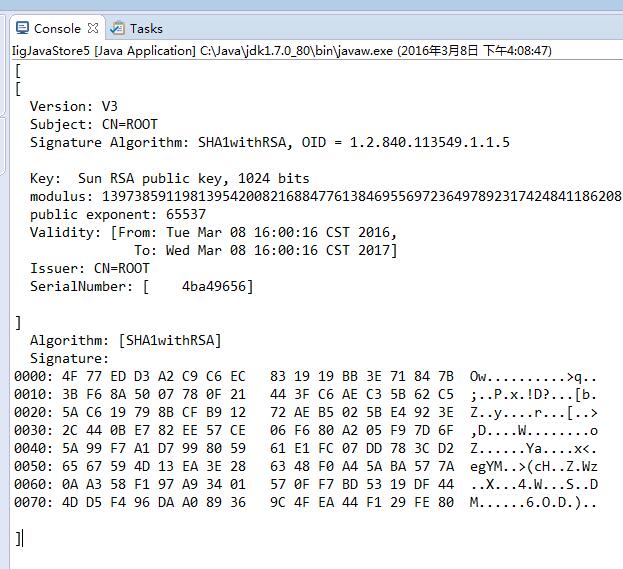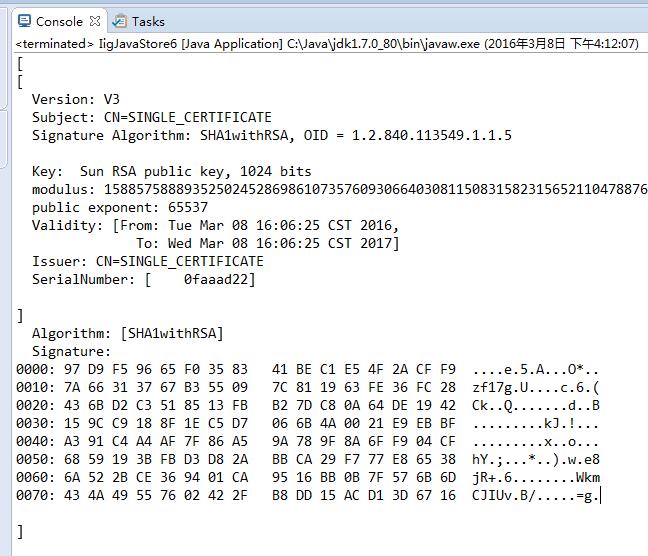RSA 是常用的非对称加密算法。最近使用时却出现了“不正确的长度”的异常,研究发现是由于待加密的数据超长所致。
RSA加密明文最大长度117字节,解密要求密文最大长度为128字节,所以在加密和解密的过程中需要分块进行。
RSA加密对明文的长度是有限制的,如果加密数据过大会抛出如下异常:
Exception in thread "main" javax.crypto.IllegalBlockSizeException: Data must not be longer than 117 bytes
at com.sun.crypto.provider.RSACipher.a(DashoA13*..)
at com.sun.crypto.provider.RSACipher.engineDoFinal(DashoA13*..)
at javax.crypto.Cipher.doFinal(DashoA13*..)
RSAUtils.java
package security;
import java.io.ByteArrayOutputStream;
import java.security.Key;
import java.security.KeyFactory;
import java.security.KeyPair;
import java.security.KeyPairGenerator;
import java.security.PrivateKey;
import java.security.PublicKey;
import java.security.Signature;
import java.security.interfaces.RSAPrivateKey;
import java.security.interfaces.RSAPublicKey;
import java.security.spec.PKCS8EncodedKeySpec;
import java.security.spec.X509EncodedKeySpec;
import java.util.HashMap;
import java.util.Map;
import javax.crypto.Cipher;
/** *//**
* <p>
* RSA公钥/私钥/签名工具包
* </p>
* <p>
* 罗纳德·李维斯特(Ron [R]ivest)、阿迪·萨莫尔(Adi [S]hamir)和伦纳德·阿德曼(Leonard [A]dleman)
* </p>
* <p>
* 字符串格式的密钥在未在特殊说明情况下都为BASE64编码格式<br/>
* 由于非对称加密速度极其缓慢,一般文件不使用它来加密而是使用对称加密,<br/>
* 非对称加密算法可以用来对对称加密的密钥加密,这样保证密钥的安全也就保证了数据的安全
* </p>
*
* @author IceWee
* @date 2012-4-26
* @version 1.0
*/
public class RSAUtils {
/** *//**
* 加密算法RSA
*/
public static final String KEY_ALGORITHM = "RSA";
/** *//**
* 签名算法
*/
public static final String SIGNATURE_ALGORITHM = "MD5withRSA";
/** *//**
* 获取公钥的key
*/
private static final String PUBLIC_KEY = "RSAPublicKey";
/** *//**
* 获取私钥的key
*/
private static final String PRIVATE_KEY = "RSAPrivateKey";
/** *//**
* RSA最大加密明文大小
*/
private static final int MAX_ENCRYPT_BLOCK = 117;
/** *//**
* RSA最大解密密文大小
*/
private static final int MAX_DECRYPT_BLOCK = 128;
/** *//**
* <p>
* 生成密钥对(公钥和私钥)
* </p>
*
* @return
* @throws Exception
*/
public static Map<String, Object> genKeyPair() throws Exception {
KeyPairGenerator keyPairGen = KeyPairGenerator.getInstance(KEY_ALGORITHM);
keyPairGen.initialize(1024);
KeyPair keyPair = keyPairGen.generateKeyPair();
RSAPublicKey publicKey = (RSAPublicKey) keyPair.getPublic();
RSAPrivateKey privateKey = (RSAPrivateKey) keyPair.getPrivate();
Map<String, Object> keyMap = new HashMap<String, Object>(2);
keyMap.put(PUBLIC_KEY, publicKey);
keyMap.put(PRIVATE_KEY, privateKey);
return keyMap;
}
/** *//**
* <p>
* 用私钥对信息生成数字签名
* </p>
*
* @param data 已加密数据
* @param privateKey 私钥(BASE64编码)
*
* @return
* @throws Exception
*/
public static String sign(byte[] data, String privateKey) throws Exception {
byte[] keyBytes = Base64Utils.decode(privateKey);
PKCS8EncodedKeySpec pkcs8KeySpec = new PKCS8EncodedKeySpec(keyBytes);
KeyFactory keyFactory = KeyFactory.getInstance(KEY_ALGORITHM);
PrivateKey privateK = keyFactory.generatePrivate(pkcs8KeySpec);
Signature signature = Signature.getInstance(SIGNATURE_ALGORITHM);
signature.initSign(privateK);
signature.update(data);
return Base64Utils.encode(signature.sign());
}
/** *//**
* <p>
* 校验数字签名
* </p>
*
* @param data 已加密数据
* @param publicKey 公钥(BASE64编码)
* @param sign 数字签名
*
* @return
* @throws Exception
*
*/
public static boolean verify(byte[] data, String publicKey, String sign)
throws Exception {
byte[] keyBytes = Base64Utils.decode(publicKey);
X509EncodedKeySpec keySpec = new X509EncodedKeySpec(keyBytes);
KeyFactory keyFactory = KeyFactory.getInstance(KEY_ALGORITHM);
PublicKey publicK = keyFactory.generatePublic(keySpec);
Signature signature = Signature.getInstance(SIGNATURE_ALGORITHM);
signature.initVerify(publicK);
signature.update(data);
return signature.verify(Base64Utils.decode(sign));
}
/** *//**
* <P>
* 私钥解密
* </p>
*
* @param encryptedData 已加密数据
* @param privateKey 私钥(BASE64编码)
* @return
* @throws Exception
*/
public static byte[] decryptByPrivateKey(byte[] encryptedData, String privateKey)
throws Exception {
byte[] keyBytes = Base64Utils.decode(privateKey);
PKCS8EncodedKeySpec pkcs8KeySpec = new PKCS8EncodedKeySpec(keyBytes);
KeyFactory keyFactory = KeyFactory.getInstance(KEY_ALGORITHM);
Key privateK = keyFactory.generatePrivate(pkcs8KeySpec);
Cipher cipher = Cipher.getInstance(keyFactory.getAlgorithm());
cipher.init(Cipher.DECRYPT_MODE, privateK);
int inputLen = encryptedData.length;
ByteArrayOutputStream out = new ByteArrayOutputStream();
int offSet = 0;
byte[] cache;
int i = 0;
// 对数据分段解密
while (inputLen - offSet > 0) {
if (inputLen - offSet > MAX_DECRYPT_BLOCK) {
cache = cipher.doFinal(encryptedData, offSet, MAX_DECRYPT_BLOCK);
} else {
cache = cipher.doFinal(encryptedData, offSet, inputLen - offSet);
}
out.write(cache, 0, cache.length);
i++;
offSet = i * MAX_DECRYPT_BLOCK;
}
byte[] decryptedData = out.toByteArray();
out.close();
return decryptedData;
}
/** *//**
* <p>
* 公钥解密
* </p>
*
* @param encryptedData 已加密数据
* @param publicKey 公钥(BASE64编码)
* @return
* @throws Exception
*/
public static byte[] decryptByPublicKey(byte[] encryptedData, String publicKey)
throws Exception {
byte[] keyBytes = Base64Utils.decode(publicKey);
X509EncodedKeySpec x509KeySpec = new X509EncodedKeySpec(keyBytes);
KeyFactory keyFactory = KeyFactory.getInstance(KEY_ALGORITHM);
Key publicK = keyFactory.generatePublic(x509KeySpec);
Cipher cipher = Cipher.getInstance(keyFactory.getAlgorithm());
cipher.init(Cipher.DECRYPT_MODE, publicK);
int inputLen = encryptedData.length;
ByteArrayOutputStream out = new ByteArrayOutputStream();
int offSet = 0;
byte[] cache;
int i = 0;
// 对数据分段解密
while (inputLen - offSet > 0) {
if (inputLen - offSet > MAX_DECRYPT_BLOCK) {
cache = cipher.doFinal(encryptedData, offSet, MAX_DECRYPT_BLOCK);
} else {
cache = cipher.doFinal(encryptedData, offSet, inputLen - offSet);
}
out.write(cache, 0, cache.length);
i++;
offSet = i * MAX_DECRYPT_BLOCK;
}
byte[] decryptedData = out.toByteArray();
out.close();
return decryptedData;
}
/** *//**
* <p>
* 公钥加密
* </p>
*
* @param data 源数据
* @param publicKey 公钥(BASE64编码)
* @return
* @throws Exception
*/
public static byte[] encryptByPublicKey(byte[] data, String publicKey)
throws Exception {
byte[] keyBytes = Base64Utils.decode(publicKey);
X509EncodedKeySpec x509KeySpec = new X509EncodedKeySpec(keyBytes);
KeyFactory keyFactory = KeyFactory.getInstance(KEY_ALGORITHM);
Key publicK = keyFactory.generatePublic(x509KeySpec);
// 对数据加密
Cipher cipher = Cipher.getInstance(keyFactory.getAlgorithm());
cipher.init(Cipher.ENCRYPT_MODE, publicK);
int inputLen = data.length;
ByteArrayOutputStream out = new ByteArrayOutputStream();
int offSet = 0;
byte[] cache;
int i = 0;
// 对数据分段加密
while (inputLen - offSet > 0) {
if (inputLen - offSet > MAX_ENCRYPT_BLOCK) {
cache = cipher.doFinal(data, offSet, MAX_ENCRYPT_BLOCK);
} else {
cache = cipher.doFinal(data, offSet, inputLen - offSet);
}
out.write(cache, 0, cache.length);
i++;
offSet = i * MAX_ENCRYPT_BLOCK;
}
byte[] encryptedData = out.toByteArray();
out.close();
return encryptedData;
}
/** *//**
* <p>
* 私钥加密
* </p>
*
* @param data 源数据
* @param privateKey 私钥(BASE64编码)
* @return
* @throws Exception
*/
public static byte[] encryptByPrivateKey(byte[] data, String privateKey)
throws Exception {
byte[] keyBytes = Base64Utils.decode(privateKey);
PKCS8EncodedKeySpec pkcs8KeySpec = new PKCS8EncodedKeySpec(keyBytes);
KeyFactory keyFactory = KeyFactory.getInstance(KEY_ALGORITHM);
Key privateK = keyFactory.generatePrivate(pkcs8KeySpec);
Cipher cipher = Cipher.getInstance(keyFactory.getAlgorithm());
cipher.init(Cipher.ENCRYPT_MODE, privateK);
int inputLen = data.length;
ByteArrayOutputStream out = new ByteArrayOutputStream();
int offSet = 0;
byte[] cache;
int i = 0;
// 对数据分段加密
while (inputLen - offSet > 0) {
if (inputLen - offSet > MAX_ENCRYPT_BLOCK) {
cache = cipher.doFinal(data, offSet, MAX_ENCRYPT_BLOCK);
} else {
cache = cipher.doFinal(data, offSet, inputLen - offSet);
}
out.write(cache, 0, cache.length);
i++;
offSet = i * MAX_ENCRYPT_BLOCK;
}
byte[] encryptedData = out.toByteArray();
out.close();
return encryptedData;
}
/** *//**
* <p>
* 获取私钥
* </p>
*
* @param keyMap 密钥对
* @return
* @throws Exception
*/
public static String getPrivateKey(Map<String, Object> keyMap)
throws Exception {
Key key = (Key) keyMap.get(PRIVATE_KEY);
return Base64Utils.encode(key.getEncoded());
}
/** *//**
* <p>
* 获取公钥
* </p>
*
* @param keyMap 密钥对
* @return
* @throws Exception
*/
public static String getPublicKey(Map<String, Object> keyMap)
throws Exception {
Key key = (Key) keyMap.get(PUBLIC_KEY);
return Base64Utils.encode(key.getEncoded());
}
}
Base64Utils.java
package security;
import java.io.ByteArrayInputStream;
import java.io.ByteArrayOutputStream;
import java.io.File;
import java.io.FileInputStream;
import java.io.FileOutputStream;
import java.io.InputStream;
import java.io.OutputStream;
import it.sauronsoftware.base64.Base64;
/** *//**
* <p>
* BASE64编码解码工具包
* </p>
* <p>
* 依赖javabase64-1.3.1.jar
* </p>
*
* @author IceWee
* @date 2012-5-19
* @version 1.0
*/
public class Base64Utils {
/** *//**
* 文件读取缓冲区大小
*/
private static final int CACHE_SIZE = 1024;
/** *//**
* <p>
* BASE64字符串解码为二进制数据
* </p>
*
* @param base64
* @return
* @throws Exception
*/
public static byte[] decode(String base64) throws Exception {
return Base64.decode(base64.getBytes());
}
/** *//**
* <p>
* 二进制数据编码为BASE64字符串
* </p>
*
* @param bytes
* @return
* @throws Exception
*/
public static String encode(byte[] bytes) throws Exception {
return new String(Base64.encode(bytes));
}
/** *//**
* <p>
* 将文件编码为BASE64字符串
* </p>
* <p>
* 大文件慎用,可能会导致内存溢出
* </p>
*
* @param filePath 文件绝对路径
* @return
* @throws Exception
*/
public static String encodeFile(String filePath) throws Exception {
byte[] bytes = fileToByte(filePath);
return encode(bytes);
}
/** *//**
* <p>
* BASE64字符串转回文件
* </p>
*
* @param filePath 文件绝对路径
* @param base64 编码字符串
* @throws Exception
*/
public static void decodeToFile(String filePath, String base64) throws Exception {
byte[] bytes = decode(base64);
byteArrayToFile(bytes, filePath);
}
/** *//**
* <p>
* 文件转换为二进制数组
* </p>
*
* @param filePath 文件路径
* @return
* @throws Exception
*/
public static byte[] fileToByte(String filePath) throws Exception {
byte[] data = new byte[0];
File file = new File(filePath);
if (file.exists()) {
FileInputStream in = new FileInputStream(file);
ByteArrayOutputStream out = new ByteArrayOutputStream(2048);
byte[] cache = new byte[CACHE_SIZE];
int nRead = 0;
while ((nRead = in.read(cache)) != -1) {
out.write(cache, 0, nRead);
out.flush();
}
out.close();
in.close();
data = out.toByteArray();
}
return data;
}
/** *//**
* <p>
* 二进制数据写文件
* </p>
*
* @param bytes 二进制数据
* @param filePath 文件生成目录
*/
public static void byteArrayToFile(byte[] bytes, String filePath) throws Exception {
InputStream in = new ByteArrayInputStream(bytes);
File destFile = new File(filePath);
if (!destFile.getParentFile().exists()) {
destFile.getParentFile().mkdirs();
}
destFile.createNewFile();
OutputStream out = new FileOutputStream(destFile);
byte[] cache = new byte[CACHE_SIZE];
int nRead = 0;
while ((nRead = in.read(cache)) != -1) {
out.write(cache, 0, nRead);
out.flush();
}
out.close();
in.close();
}
}
RSATester.java
package security;
import java.util.Map;
public class RSATester {
static String publicKey;
static String privateKey;
static {
try {
Map<String, Object> keyMap = RSAUtils.genKeyPair();
publicKey = RSAUtils.getPublicKey(keyMap);
privateKey = RSAUtils.getPrivateKey(keyMap);
System.err.println("公钥: \n\r" + publicKey);
System.err.println("私钥: \n\r" + privateKey);
} catch (Exception e) {
e.printStackTrace();
}
}
public static void main(String[] args) throws Exception {
test();
testSign();
}
static void test() throws Exception {
System.err.println("公钥加密——私钥解密");
String source = "这是一行没有任何意义的文字,你看完了等于没看,不是吗?";
System.out.println("\r加密前文字:\r\n" + source);
byte[] data = source.getBytes();
byte[] encodedData = RSAUtils.encryptByPublicKey(data, publicKey);
System.out.println("加密后文字:\r\n" + new String(encodedData));
byte[] decodedData = RSAUtils.decryptByPrivateKey(encodedData, privateKey);
String target = new String(decodedData);
System.out.println("解密后文字: \r\n" + target);
}
static void testSign() throws Exception {
System.err.println("私钥加密——公钥解密");
String source = "这是一行测试RSA数字签名的无意义文字";
System.out.println("原文字:\r\n" + source);
byte[] data = source.getBytes();
byte[] encodedData = RSAUtils.encryptByPrivateKey(data, privateKey);
System.out.println("加密后:\r\n" + new String(encodedData));
byte[] decodedData = RSAUtils.decryptByPublicKey(encodedData, publicKey);
String target = new String(decodedData);
System.out.println("解密后: \r\n" + target);
System.err.println("私钥签名——公钥验证签名");
String sign = RSAUtils.sign(encodedData, privateKey);
System.err.println("签名:\r" + sign);
boolean status = RSAUtils.verify(encodedData, publicKey, sign);
System.err.println("验证结果:\r" + status);
}
}
下面是微软的.net系统下的rsa分块加密
待加密的字节数不能超过密钥的长度值除以 8 再减去 11(即:RSACryptoServiceProvider.KeySize / 8 - 11),而加密后得到密文的字节数,正好是密钥的长度值除以 8(即:RSACryptoServiceProvider.KeySize / 8)。
所以,如果要加密较长的数据,则可以采用分段加解密的方式,实现方式如下:
namespace Macroresolute.RSACryptoService
{
public static class RSACrypto
{
private static readonly Encoding Encoder = Encoding.UTF8;
public static String Encrypt(this String plaintext)
{
X509Certificate2 _X509Certificate2 = RSACrypto.RetrieveX509Certificate();
using (RSACryptoServiceProvider RSACryptography = _X509Certificate2.PublicKey.Key as RSACryptoServiceProvider)
{
Byte[] PlaintextData = RSACrypto.Encoder.GetBytes(plaintext);
int MaxBlockSize = RSACryptography.KeySize / 8 - 11; //加密块最大长度限制
if (PlaintextData.Length <= MaxBlockSize)
return Convert.ToBase64String(RSACryptography.Encrypt(PlaintextData, false));
using (MemoryStream PlaiStream = new MemoryStream(PlaintextData))
using (MemoryStream CrypStream = new MemoryStream())
{
Byte[] Buffer = new Byte[MaxBlockSize];
int BlockSize = PlaiStream.Read(Buffer, 0, MaxBlockSize);
while (BlockSize > 0)
{
Byte[] ToEncrypt = new Byte[BlockSize];
Array.Copy(Buffer, 0, ToEncrypt, 0, BlockSize);
Byte[] Cryptograph = RSACryptography.Encrypt(ToEncrypt, false);
CrypStream.Write(Cryptograph, 0, Cryptograph.Length);
BlockSize = PlaiStream.Read(Buffer, 0, MaxBlockSize);
}
return Convert.ToBase64String(CrypStream.ToArray(), Base64FormattingOptions.None);
}
}
}
public static String Decrypt(this String ciphertext)
{
X509Certificate2 _X509Certificate2 = RSACrypto.RetrieveX509Certificate();
using (RSACryptoServiceProvider RSACryptography = _X509Certificate2.PrivateKey as RSACryptoServiceProvider)
{
Byte[] CiphertextData = Convert.FromBase64String(ciphertext);
int MaxBlockSize = RSACryptography.KeySize / 8; //解密块最大长度限制
if (CiphertextData.Length <= MaxBlockSize)
return RSACrypto.Encoder.GetString(RSACryptography.Decrypt(CiphertextData, false));
using (MemoryStream CrypStream = new MemoryStream(CiphertextData))
using (MemoryStream PlaiStream = new MemoryStream())
{
Byte[] Buffer = new Byte[MaxBlockSize];
int BlockSize = CrypStream.Read(Buffer, 0, MaxBlockSize);
while (BlockSize > 0)
{
Byte[] ToDecrypt = new Byte[BlockSize];
Array.Copy(Buffer, 0, ToDecrypt, 0, BlockSize);
Byte[] Plaintext = RSACryptography.Decrypt(ToDecrypt, false);
PlaiStream.Write(Plaintext, 0, Plaintext.Length);
BlockSize = CrypStream.Read(Buffer, 0, MaxBlockSize);
}
return RSACrypto.Encoder.GetString(PlaiStream.ToArray());
}
}
}
private static X509Certificate2 RetrieveX509Certificate()
{
return null; //检索用于 RSA 加密的 X509Certificate2 证书
}
}
}
注:以上加密方法返回的字符串类型为原始的 Base-64 ,若要用于 URL 传输,需另行处理!

